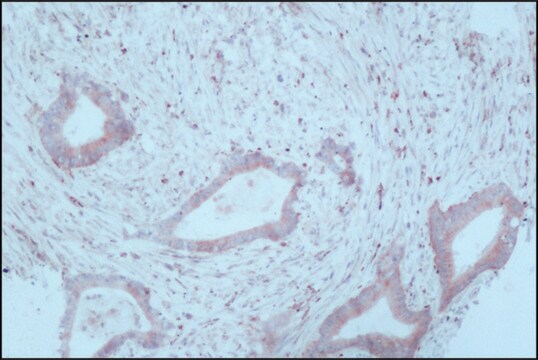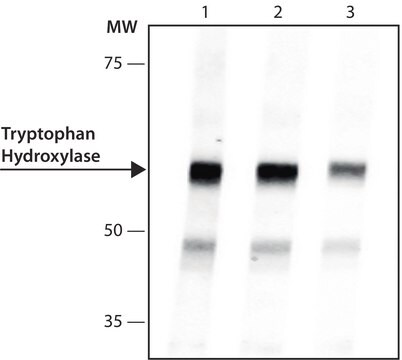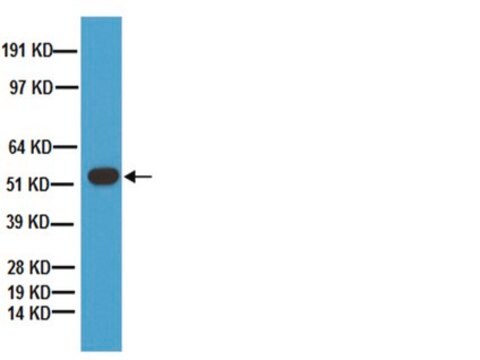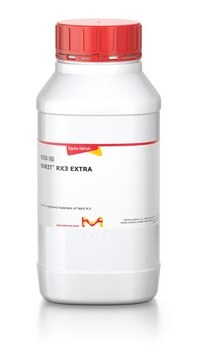推薦產品
生物源
rat
共軛
unconjugated
抗體表格
purified immunoglobulin
抗體產品種類
primary antibodies
無性繁殖
IM7, monoclonal
形狀
buffered aqueous solution
物種活性
mouse, horse, canine, human, feline
濃度
1 mg/mL
技術
flow cytometry: suitable
同型
IgG2b
NCBI登錄號
UniProt登錄號
運輸包裝
wet ice
儲存溫度
2-8°C
目標翻譯後修改
unmodified
基因資訊
human ... CD44(960)
一般說明
The CD44 (cell-surface glycoprotein) gene with 20 exons is mapped to human chromosome 11p13. The gene codes for a transmembrane glycoprotein.
The rat monoclonal antibody IM7 reacts with CD44 antigen (Phagocyte glycoprotein 1), an 80-95 kDa transmembrane glycoprotein (hyaladherin family) present on the most of cells and tissues (leukocytes, endothelial cells, mesenchymal cells, etc.); it is negative on platelets and hepatocytes. The antibody reacts with all isoforms of mouse CD44.
免疫原
Dexamethasone-induced cells of the SJL mouse spontaneous myeloid leukemia M1
應用
Monoclonal Anti-CD44 antibody produced in rat has been used in immunohistochemistry.
The reagent is designed for Flow Cytometry analysis. Suggested working dilution is 1 μg/mL of sample. Indicated dilution is recommended starting point for use of this product. Working concentrations should be determined by the investigator.
生化/生理作用
CD44 (cell-surface glycoprotein) is involved in cell-cell and cell-extracellular matrix interactions. It plays an important role in lymphocyte homing and lymphocyte activation. It also acts as a metastasis suppressor gene for prostatic cancer. Overexpression of CD44 leads to esophageal squamous cell carcinoma (ESCC). CD44 inhibits macrophage multinucleation by interacting with its ligands, hyaluronic acid, chondroitin sulfates and osteopontin. 100kDa form of CD44, facilitates the binding of poliovirus to HeLa cells. In addition, it also implicated in the infection of mononuclear phagocytes by human immunodeficiency virus (HIV).
特點和優勢
Evaluate our antibodies with complete peace of mind. If the antibody does not perform in your application, we will issue a full credit or replacement antibody. Learn more.
外觀
Solution in phosphate buffered saline, pH 7.4, with 15 mM sodium azide.
免責聲明
Unless otherwise stated in our catalog or other company documentation accompanying the product(s), our products are intended for research use only and are not to be used for any other purpose, which includes but is not limited to, unauthorized commercial uses, in vitro diagnostic uses, ex vivo or in vivo therapeutic uses or any type of consumption or application to humans or animals.
未找到適合的產品?
試用我們的產品選擇工具.
儲存類別代碼
10 - Combustible liquids
閃點(°F)
Not applicable
閃點(°C)
Not applicable
A rare missense variant in RCL1 segregates with depression in extended families
Amin N
Molecular Psychiatry (2017)
Heli Li et al.
Journal of immunology research, 2018, 4807145-4807145 (2019-01-24)
The immunologic interaction between parenchyma cells and encircling inflammatory cells is thought to be the most important mechanism of biliary damage and repair in primary sclerosing cholangitis (PSC). Monocytes/macrophages as master regulators of hepatic inflammation have been demonstrated to contribute
CD44 occupancy prevents macrophage multinucleation.
Sterling H
The Journal of Cell Biology, 143, 837-847 (1998)
Autophagy supports generation of cells with high CD44 expression via modulation of oxidative stress and Parkin-mediated mitochondrial clearance
Whelan KA
Oncogene, 36, 4843-4858 (2017)
Gongcai Qiu et al.
International journal of oncology, 55(1), 45-58 (2019-05-07)
The present study aimed to explore the long non‑coding RNA (lncRNA) expression profiles and correlation of lnc‑PKD2‑2‑3 with tumor features and prognosis, and to investigate its effect on regulating cancer‑cell stemness and its potential as a cancer stem cell (CSC) marker
我們的科學家團隊在所有研究領域都有豐富的經驗,包括生命科學、材料科學、化學合成、色譜、分析等.
聯絡技術服務







